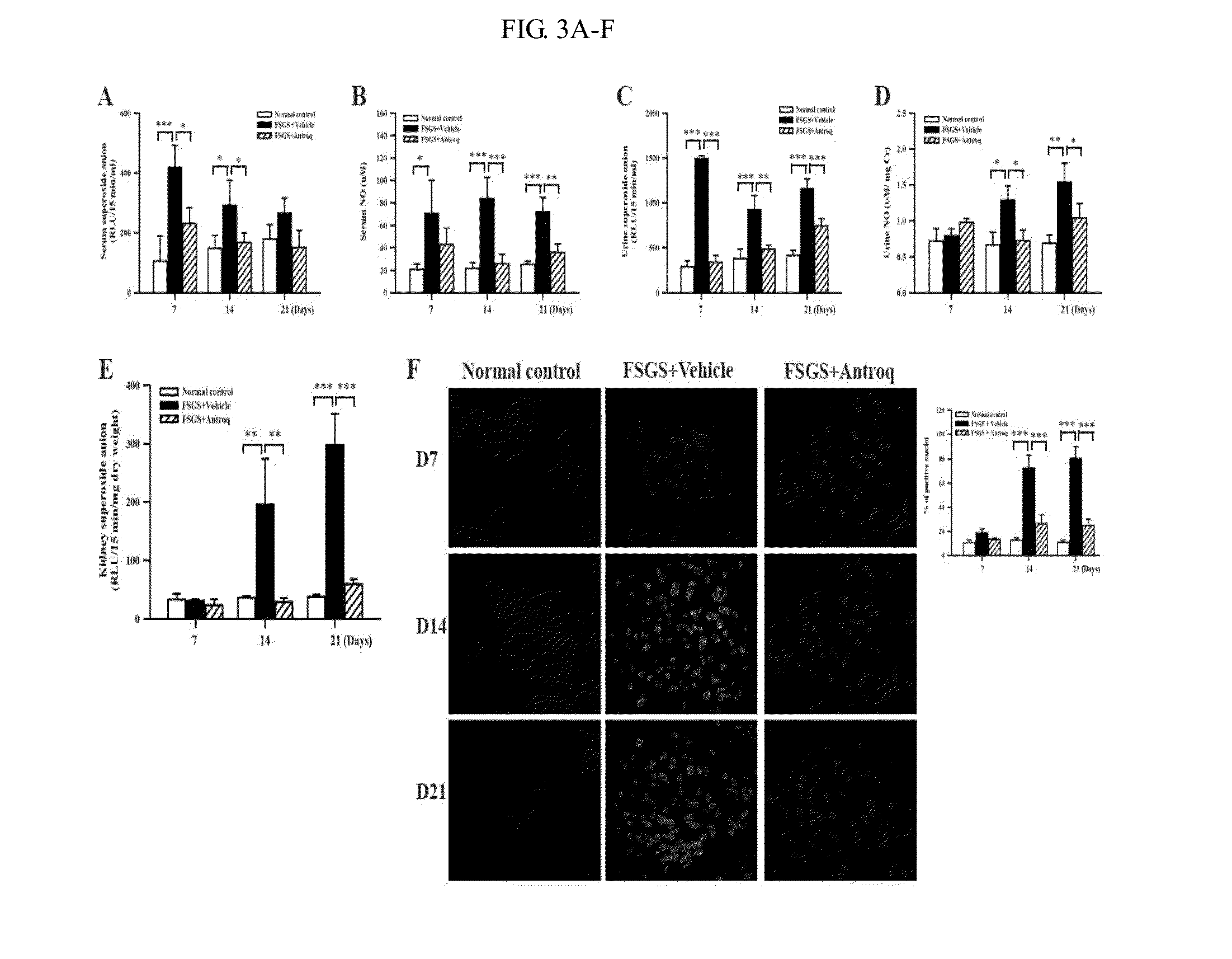Methods and compositions for treating kidney disorders
a technology for kidney disorders and compositions, applied in the direction of drug compositions, urinary disorders, biocide, etc., can solve the problems of poor treatment effect in terms of the progression of renal lesions, protein leakage from the blood into urine, scarring and other issues
- Summary
- Abstract
- Description
- Claims
- Application Information
AI Technical Summary
Benefits of technology
Problems solved by technology
Method used
Image
Examples
example
Example 1
Preparation of the Exemplary Compound 1
[0361]The exemplary Compound 1 (i.e., Antroq) was isolated from the solid-state fermented mycelium of Antrodia camphorata followed the known method. (Lee, et al., Planta Med, 73: 1412-1415, 2007) Compound 1 is effective at a range of 10-50 mg / kg body weight, based on a previous study and empirical use. (Chang, et al., Evid Based Complement Alternat Med, 2008) Unless indicating otherwise, 50 mg / kg body weight of Compound 1 was used as a dosage in the following experiments.
[0362]Alternatively, the exemplary Compound 1 may be prepared from 4-hydroxy-2,3-dimethoxy-6-methylcyclohexa-2,5-dienone or the like. Similarly, other cyclohexenone compounds having the structure
are isolated from Antrodia camphorata or prepared synthetically or semi-synthetically from the appropriate starting materials. An ordinary skilled in the art would readily utilize appropriate conditions for such synthesis.
example 2
Establishment of the FSGS Model and Experimental Protocol
[0363]Experiments described herein were performed on 8-week-old female BALB / c mice. The FSGS mice were injected intravenously with a single dose of adriamycin (0.1 mg / 10 g body weight). The mice were given Compound 1 six hours before adriamycin injection by gavage daily till sacrifice. BALB / c mice intraperitoneal injected with normal saline were used as normal controls, while ASLN mice given vehicle (corn oil) by gavage were used as disease controls. Mice were killed at day 7, 14, or 21 after disease induction, and spleen, renal cortical tissue, and blood samples collected and stored appropriately until analysis. All animal experiments were performed with the ethical approval of the Institutional Animal Care and Use Committee of The National Defense Medical Center, Taiwan and performed according to the ethical rules in the NIH Guide for the Care and Use of Laboratory Animals.
Clinical and Renal Function Evaluation
[0364]Urine sa...
example 3
ROS and NO Determination
[0367]Kidney in-situ superoxide anion production was determined by DHE labeling according to the known method. (Wu, et al., Nephrol Dial Transplant, 2008, 23: 3082-3090, or Ka, et al., J. Am. Soc. Nephrol. 2007, 18:2473-2485) Fluorescent images were quantified by counting the percentage of positive nuclei in the total nuclei per kidney cross section. Sera and kidney tissues were assessed for superoxide anion according to the known method. (Wu, et al., J Pineal Res, 2001, 30: 147-156, or Ka, et al., J. Am. Soc. Nephrol. 2007, 18:2473-2485) For ROS levels of serum, urine, and renal tissue, the samples were incubated with Krebs-HEPES buffer, and lucigenin (Sigma-Aldrich Chemical Co, MO) at 1.25 mM was used as substrate. Luminescence counts were obtained in duplicate at 15 sec intervals by a microplate luminometer (Hidex Microplate Luminometer, Finland), as previously described (Kretzler, et al.,. Virchows Arch, 425: 181-193, 1994). The superoxide anion activity ...
PUM
| Property | Measurement | Unit |
|---|---|---|
| volume | aaaaa | aaaaa |
| volume | aaaaa | aaaaa |
| volume | aaaaa | aaaaa |
Abstract
Description
Claims
Application Information
 Login to View More
Login to View More - R&D
- Intellectual Property
- Life Sciences
- Materials
- Tech Scout
- Unparalleled Data Quality
- Higher Quality Content
- 60% Fewer Hallucinations
Browse by: Latest US Patents, China's latest patents, Technical Efficacy Thesaurus, Application Domain, Technology Topic, Popular Technical Reports.
© 2025 PatSnap. All rights reserved.Legal|Privacy policy|Modern Slavery Act Transparency Statement|Sitemap|About US| Contact US: help@patsnap.com



